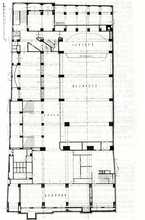Archa Theatre
Josef Gočár
Na Poříčí 26, 110 00, | |
| pokaż na mapie | http://www.archatheatre.cz/en/ |
ważne wydarzenia
The bank issued a call for bids to construct an extension to Gočár´s original building. Competition, with participation of architect Kamil Roškot, was won by the design by František Marek. The new building was realized in 1937-38 and building approval was issued on 16.2.1939.
osoby
historia
In the 1930s, the capacity of the Czechoslovak Legions´ Bank (N. 1046, 1921-23 according to the design by Josef Gočár) ceased to be sufficient for increasing operating demands, therefore the bank bought the building in Na Poříčí Street, former U Rozvařilů brewery, for the purpose of spatial extension. At the same time, the bank invited tenders for a solution of extension to Gočár´s original building in the form of a National style. The competition, for instance also with participation of architect Kamil Roškot, was won by František Marek. The new building was realized by Josef Blecha Building Company with cooperation of the firm Dr. K. Skorkovský and Lanna, the supplier of ferroconcrete structure. Approval for the building was issued on 16.2.1939.
This office building in Functionalist style had a town passage across the ground floor, with other operations affiliated to it. A large hall, situated mainly in the basement, initially intended to be a concert hall, commenced to be used by the E. F. Burian Theatre Company since 1939 after partial reconstruction. Emil František Burian (1904-1959), a poet, actor, stage director and member of the Devětsil group, led an avant-garde, leftist orientated venue that not only presented translated plays, but original plays and drama as well responding to current social events. Theatre operated here under variable names even after a compulsory break caused by the Second World War. Partial building reconstruction of the interior was taking place in the1950s and 1960s.
The Prague municipal government announced recruitment for a position of a new director of the E. F. Burian Theatre in 1991,in which Ondřej Hrab succeeded with his project. Submitted ambition for the art space was to introduce unconventional, progressive mise-en-scenes conducted across individual genres. Adaptation for Archa theatre was carried out according to the design by Ivan Plicka and scenographer and architect Miroslav Melena, the latter focused on theatre technology facilities. Reconstruction commenced in September 1992 and approval for the building was issued in May of 1994. Ceremonial reopening took place with a joint performance by Japanese dancer Mino Tanaka and musician John Cale.
Reconstruction of Archa Theatre was awarded on the international exhibition PQ 95 with a silver award. The distinct character of the theatre is provided by graphic styling by Robert V. Novák.
Present state
The theatre is accessible from the passage through four two-leaf doors, inserted into burnished metal frames. A monumental staircase that is divided into two symmetrically laid flights, seduces spectators to enter into the basement spaces of the theatre. A cloakroom is set into a recess between two flights. There is a clubroom for visitors on one side in the foyer axis and an entrance into the hall on the opposite end of the space. Mentioned spaces are continuously used for short-term exhibitions.
Multifunctional space is divided into two halls, grand and minor that are available to be adjusted for various types of productions. Halls are interconnected by a system of movable walls and it is possible to reach a maximum capacity of 1200 spectators after their connection. The bigger of both the halls is bordered by a gallery and it is technically perfectly equipped to enable very variable usage of the space, where miscellaneous concerts or dance performances take place besides theatre plays. Flexible variability of the arrangement is secured by sliding, mechanically lifted boards of a square plan (of 4 x 4 metres size), and with their help it is possible to rearrange the hall into a form required by the character of the performance.
The premiere of the Leaving by Václav Havel under David Radok´s direction was introduced in Archa in 2008.
Employed sources and literature:
- Archiv Odboru výstavby, Městská část Praha 1, čp. 1047.
- Rybár, Ctibor (ed.): Co je co v Praze. Praha 1989, s. 197.
- JH [Jiří Hilmera], čp. 1047/II in: Růžena Baťková (ed.), Umělecké památky Prahy. Nové Město. Vyšehrad. Vinohrady. Praha 1998, s. 555.
- Hilmera, Jiří: Česká divadelní architektura. Praha 1999, s. 173, 181, 292.
- Hrab, Ondřej: Divadlo Archa, Stavba VII, 2000, č. 6, s. 60.
- Svoboda, J. E. & Noll, J. : Praha 1945-2003. Kapitoly z poválečné a současné architektury. Praha 2006, s. 42, 291.
autor: Vendula Hnídková
Vendula Hnídková:
informacje dodatkowe
nie wprowadzono żadnych informacji
Dodaj informacje

















